Camping can change your life. It’s a chance to find peace in nature or have fun with friends. This Beginner Camping Guide will give you the tips and gear you need for your first trip.
We’ll cover everything from picking the right campsite to packing what you need. You’ll be ready to explore nature and make memories that last a lifetime!
Key Takeaways
- Understand the basics of camping and its various types.
- Choose your first campsite based on your skill level.
- Invest in suitable camping gear for beginners.
- Pack essential items to ensure comfort and safety.
- Learn vital tips for setting up your campsite efficiently.
- Stay informed about wildlife and emergency preparedness.
- Hone basic wilderness survival skills for safety.
Understanding the Basics of Camping
Camping is a special way to connect with nature. It lets you leave behind the daily rush and enjoy the outdoors. I started camping to see how it brings people together. I learned about the many types of camping.
What is Camping?
Camping is about enjoying the outdoors. You can have campfires, stargaze, hike, and cook outside. It’s a chance to be adventurous and learn new skills. Knowing the basics is key for a great camping trip, especially for beginners.
Types of Camping
There are many camping styles, each with its own perks and challenges. Let’s take a quick look:
| Type of Camping | Description | Benefits | Challenges |
|---|---|---|---|
| Tent Camping | Staying in tents at campgrounds or in the wild | Affordable, immersive experience with nature | Weather exposure, setup time |
| RV Camping | Traveling in recreational vehicles or trailers | Comfort, amenities like a kitchen and bathroom | Gas costs, campsite size limitations |
| Backpacking | Carrying all gear in a backpack while hiking to a remote site | Exercise, access to less crowded areas | Requires extensive planning, lightweight gear |
Choosing the right camping style is important for beginners. Whether you like RVs or backpacking, each offers a unique nature experience. Finding the right fit can make your camping trip unforgettable. For more info, check out this useful guide.
The Ultimate Guide to Camping for Beginners
Starting your camping adventure can be thrilling yet daunting. Picking the right campsite is key to a great trip. This guide offers tips on finding a campsite that fits your needs. It also suggests top spots for new campers.
Choosing Your First Campsite
When picking a campsite, I look at a few important things:
- Accessibility: Make sure it’s easy to get to, especially if you’re new to the outdoors.
- Safety: Choose places known for being safe and have good feedback from other campers.
- Nearby Amenities: Having restrooms, water, and fire pits nearby is a big plus, especially for beginners.
Using a campsite setup guide helps you organize your space better. It makes your stay more enjoyable.
Best Camping Locations for Newbies
For beginners, I suggest checking out these easy spots:
| Location | Features | Accessibility |
|---|---|---|
| Yosemite National Park | Stunning scenery, well-marked trails | Accessible via car, family-friendly |
| Great Smoky Mountains | Rich biodiversity, scenic viewpoints | Easy access from multiple highways |
| Joshua Tree National Park | Unique rock formations, starry skies | Good access to campgrounds and facilities |
These places are perfect for first-timers. They offer a friendly setting and lots of outdoor fun. A camping checklist for beginners helps make sure you have everything you need.
Essential Camping Gear for Beginners
Starting a camping trip needs the right gear for a good time. The right stuff makes things easier, safer, and more fun outdoors.
Tents: Finding the Right One
Finding a tent that fits your needs is key for a great camping trip. There are many types of tents, each for different camping styles and places:
- Dome Tents: These are stable and easy to set up.
- Backpacking Tents: Light and small, great for hiking.
- Family Tents: Big and comfy for groups.
Good tents make a big difference. Think about size, weight, and how well they handle the weather.
Sleeping Bags and Pads
Getting a good night’s sleep is important while camping. Picking the right sleeping bag and pad is crucial. Look for these features:
- Temperature Rating: Pick a sleeping bag for the weather you’ll face.
- Insulation Type: Synthetic is good for wet, down is light and packs small.
- Sleeping Pads: A good pad adds warmth and comfort.
Pairing a quality sleeping bag with a good pad keeps you warm and comfy at night.
Cooking Gear Essentials
A good camping kitchen makes outdoor cooking better. Here are the must-haves:
- Portable Stoves: Great for cooking and boiling water.
- Cookware: Light pots and pans for easy carrying.
- Utensils: Forks, knives, spoons, cutting boards, and spatulas.
- Coolers: Keep food fresh for longer trips.

With the right gear, like a good tent, cozy sleeping setup, and cooking tools, you’re set for a great camping trip. Planning and getting ready lead to amazing outdoor experiences.
Beginner Camping Essentials: What to Pack
Getting ready for your first camping trip is both exciting and a bit daunting. A good packing list makes things easier. It ensures you don’t forget anything important. Here’s what you need to remember for your first camping trip.
Clothing and Footwear
Choosing the right clothes and shoes is key for a comfy trip. Think about the weather and where you’ll be walking. Here’s what you should pack:
- Moisture-wicking base layers
- Insulating mid-layers (like fleece or down jackets)
- Waterproof outer layers (jacket and pants)
- Durable hiking boots or shoes
- Warm hat and gloves (if it’s cold)
- Multiple pairs of socks
Food and Water Supplies
Having enough food and water is vital for your camping trip. Make sure you pack enough to keep you energized. Here’s a quick list:
- Non-perishable food items (such as pasta, rice, canned beans)
- Snacks (nuts, energy bars, dried fruit)
- Fresh fruits and vegetables (if you have a fridge)
- Water bottles or hydration bladders (at least a gallon per person per day)
- Water purification tablets or filter (if needed)
First Aid Kit Recommendations
Being ready for small injuries can make a big difference. A good first aid kit is essential. Here’s what to include:
- Adhesive bandages and gauze
- Antiseptic wipes and ointment
- Pain relievers (like ibuprofen or acetaminophen)
- Allergy medication (if you have allergies)
- For serious injuries, include a splint and emergency blanket
Setting Up Your Campsite
Setting up a campsite right can make your camping trip better. This guide helps you create a neat and organized space. It’s important to choose a layout that’s safe and fun.
Campsite Layout and Organization
When I get to a campsite, I look for a flat and safe spot. It should be free of debris to avoid injuries and discomfort. Here are some key areas to consider for your layout:
- Cooking Zone: Keep this area away from tents and where you sleep. This prevents smoke and splatters. Use a portable stove or grill on a solid base.
- Sleeping Zone: Make sure tents are on level ground for comfort and safety. Don’t set up near water to avoid flooding.
- Relaxation Zone: Choose a spot for sitting and enjoying the view. Camping chairs or a hammock are great options.
Being organized makes your campsite more comfortable. These campsite setup guide tips will make your outdoor time better.
Camping Tips for a Successful Trip
To have a great time outdoors, I plan carefully and think about many things. Good preparation helps me enjoy my trip more and avoid surprises. Here are some camping tips that help me enjoy nature more.
Planning Your Activities
Having a plan for my camping trip is key. It lets me choose what to do and make the most of my time. Here are some activities I always plan for:
- Research hiking trails that fit my group’s skill level.
- Find fishing spots if we have rods.
- Plan campfire nights for stories and bonding.
Weather Considerations
Weather can change suddenly, so I always check the forecast. I also keep an eye on updates during my trip. Here are some important weather tips:
- Check the forecast every day to see if the weather will change.
- Watch for signs like cloud patterns or wind shifts.
- Change my plans if the weather doesn’t look good to stay safe and have fun.
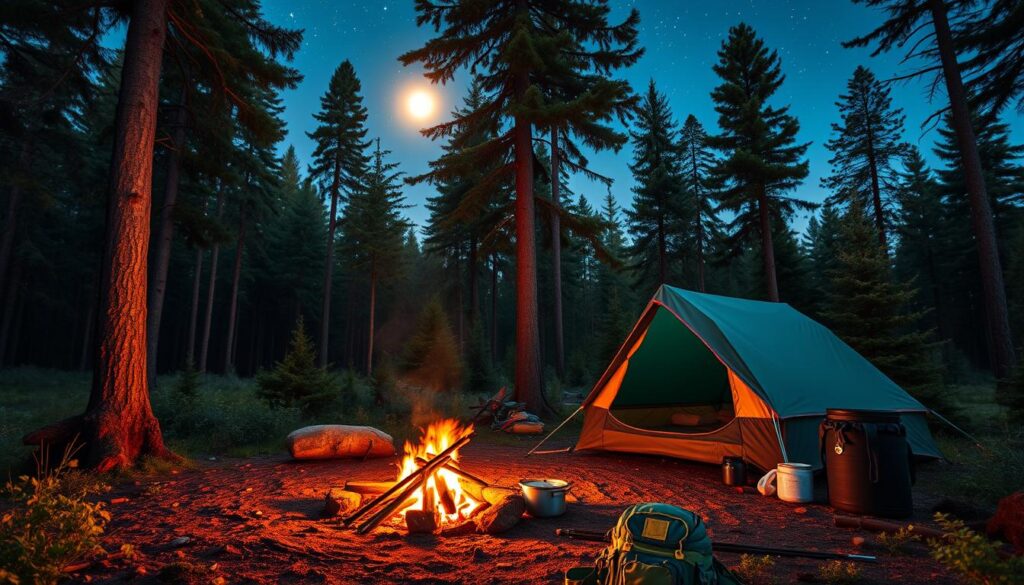
By using these camping tips, I can enjoy my outdoor adventures more. Planning and watching the weather can make a good trip great.
| Activity | Description |
|---|---|
| Hiking | Explore trails suited to skill levels and interests. |
| Fishing | Find local spots and gather necessary equipment. |
| Campfire | Gather around for warmth, cooking, and storytelling. |
| Weather Watching | Monitor conditions to adjust plans accordingly. |
Camping Safety Tips
When you go camping, safety is key. Camping safety tips are the foundation of a fun outdoor trip. Knowing your surroundings and wildlife can help avoid dangers.
Wildlife Awareness
It’s important to understand animal behavior in the wild. I always keep food safe to avoid attracting animals. Using bear-proof containers and keeping food away from where I sleep is a must.
Learning about local wildlife helps me stay safe. Knowing their habits and signs like tracks or droppings helps me prepare. This way, I can enjoy camping safely.
Emergency Preparedness
Being ready for emergencies is crucial when camping. I carry a first aid kit, water filter, and emergency whistle. I also have a list of camping safety tips.
Having the right gear, like flint and a map, is important. Knowing how to handle sudden weather changes or injuries boosts my confidence. For more on what to pack for your first camping trip, check out this guide.
Wilderness Survival Skills for Beginners
Learning wilderness survival skills is key for any camper. Knowing how to navigate and build a fire makes camping safer and more enjoyable. Here are some camping tips to help you on your next adventure.
Basic Navigation Skills
Knowing how to navigate is crucial in the wild. Using a compass and map helps avoid getting lost. Here are some important techniques:
- Using a Compass: Learn how to use a compass. Find directions by aligning the needle with your path.
- Reading Maps: Understand topographic maps. They show terrain, elevation, and water sources, vital for navigation.
- Landmarks: Use landmarks to guide you. Recognizing natural features improves your navigation.
- Sun Compass: Use the sun to find directions. This helps during the day.
Fire Building Techniques
Learning to build a fire is essential. A fire provides warmth, cooks food, and signals for help. Here’s how to do it:
- Gather Materials: Collect dry wood, twigs, and tinder. Dry leaves, bark, or small wood pieces are great for starting a fire.
- Fire Lay Techniques: Use teepee or log cabin layouts. They improve airflow and flame height while keeping you safe.
- Ignition: Use matches, lighters, or fire-starting kits. Ferro rods or flint and steel are good alternatives when needed.
- Maintaining Fire: Add larger logs slowly to keep the fire burning for heat and cooking.
Learning wilderness survival skills changes camping from fun to empowering. Being good at navigation and fire-building makes you safer and more confident. With these skills, you can enjoy the outdoors responsibly and safely.
Conclusion
As I finish this beginner camping guide, it’s clear that getting ready and knowing what to do is key. I’ve shared important camping tips. These cover picking your first campsite to setting up with the right gear.
Each tip is meant to make you feel more confident for your outdoor adventure. It’s all about being ready and enjoying the journey.
Camping lets me connect with nature and feel refreshed. I hope you’ll start your own camping journey. Learning how to navigate or build a campfire is all part of the fun.
So, get ready, plan well, and explore the world. With the right attitude and this guide, your camping trips will be amazing. Let’s enjoy the beauty of camping together!
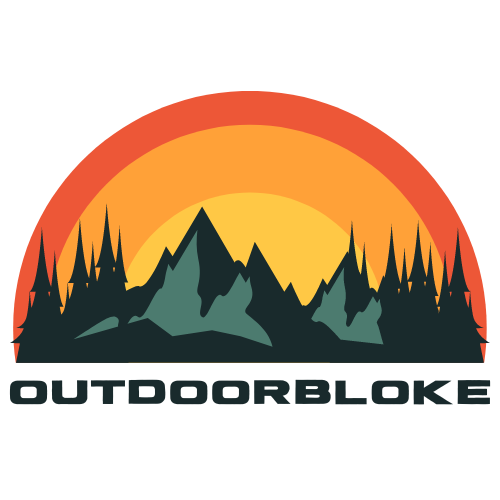
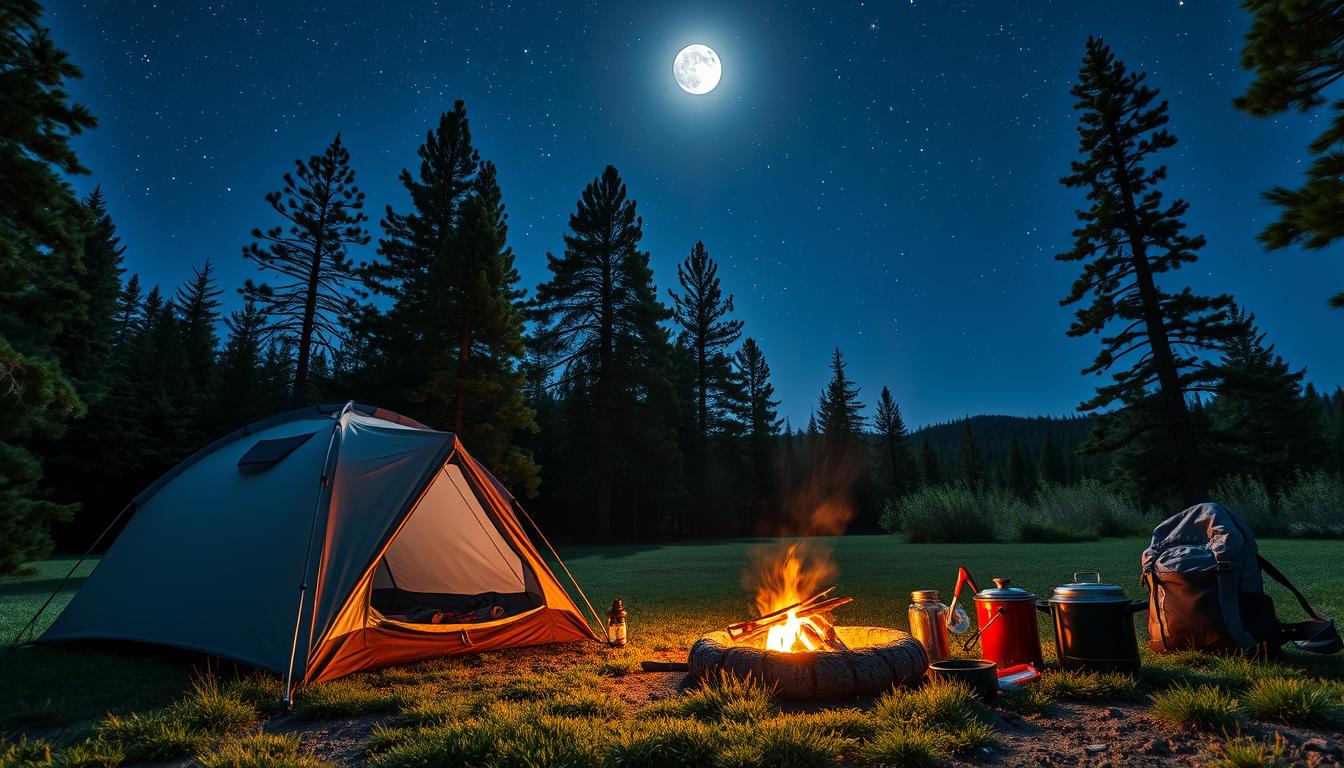

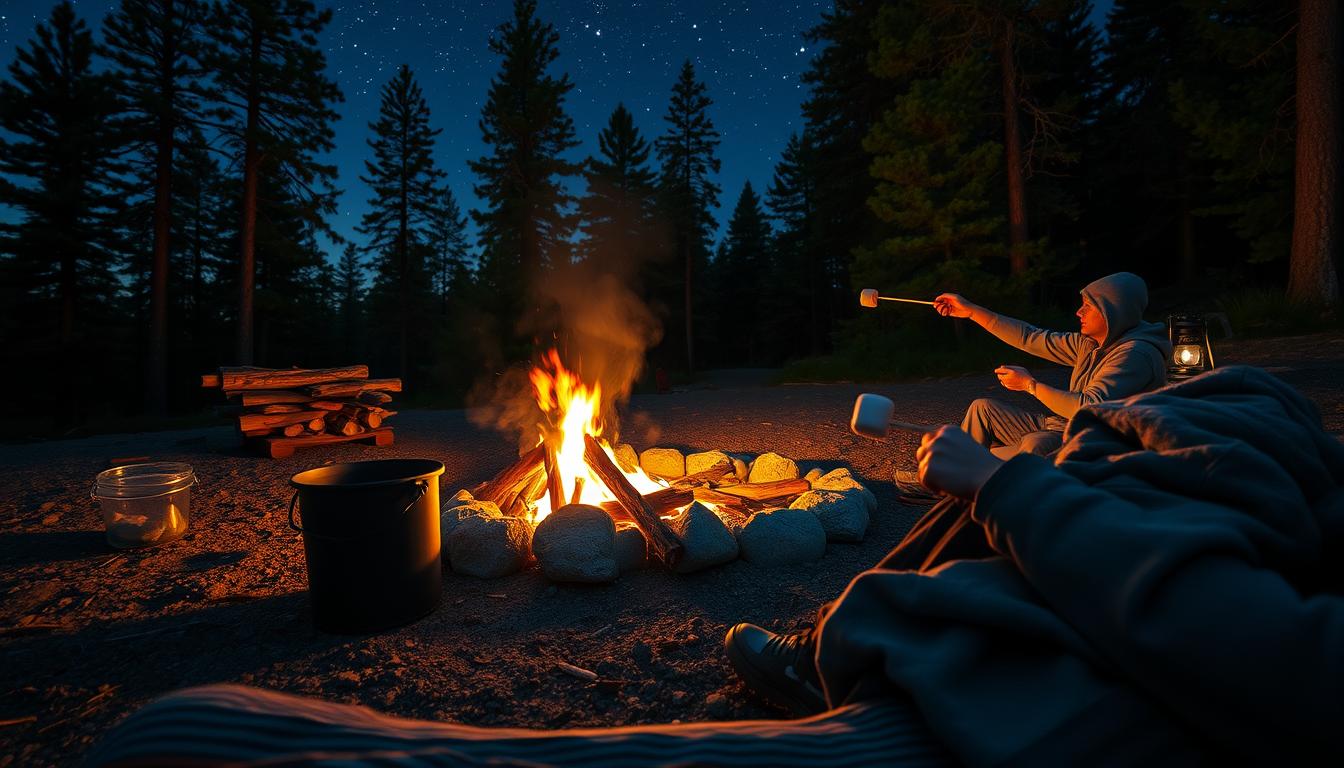
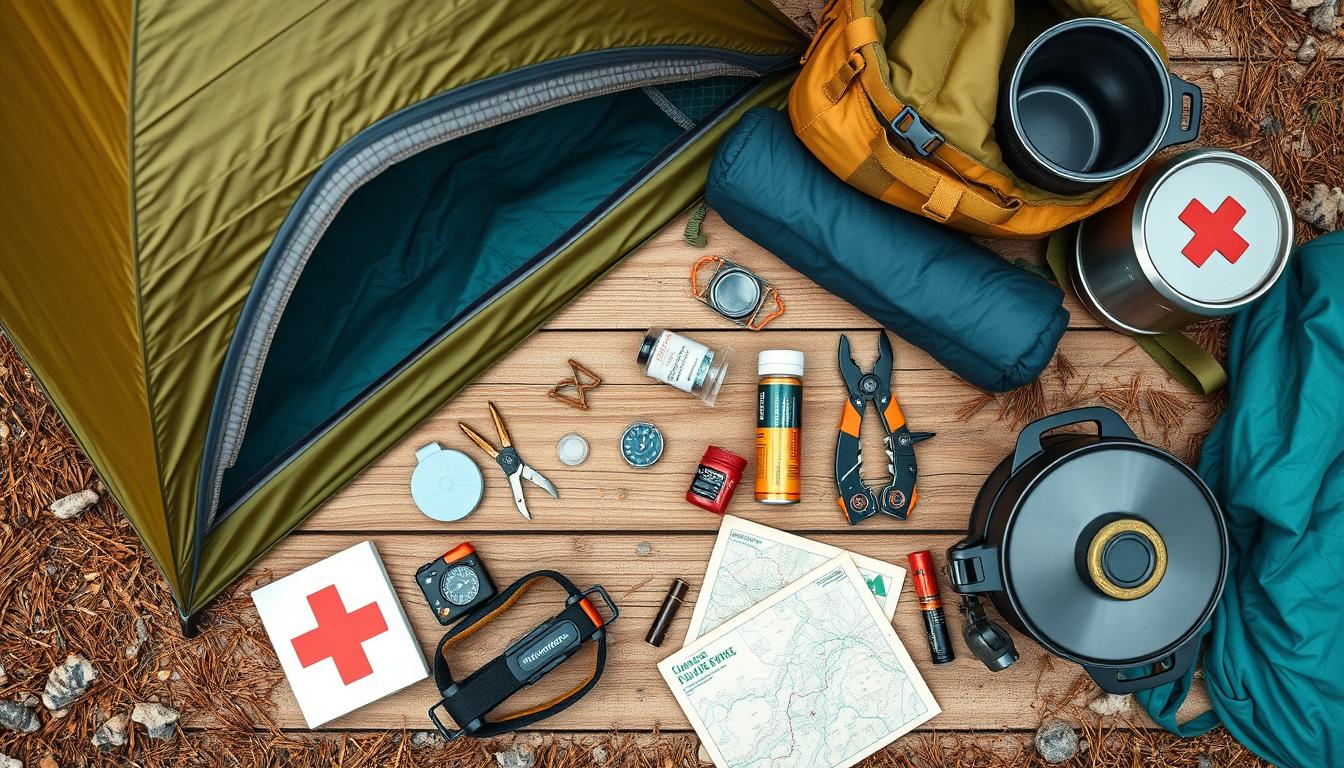
Leave a Reply